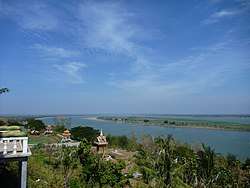Kampong Cham Province
| Kampong Cham កំពង់ចាម | |
|---|---|
| Province | |
 View of Kampong Cham from Hanchey Temple | |
 Map of Cambodia highlighting Kampong Cham | |
| Coordinates: 11°59′N 105°27′E / 11.983°N 105.450°ECoordinates: 11°59′N 105°27′E / 11.983°N 105.450°E | |
| Country |
|
| Provincial status | 1907 |
| Capital | Kampong Cham |
| Government | |
| • Governor | Kouch Chamroeun (CPP) |
| • National Assembly |
10 / 125
|
| Area | |
| • Total | 4,549 km2 (1,756 sq mi) |
| Area rank | Ranked 18th |
| Population (2008)[1] | |
| • Total | 928,694 |
| • Rank | Ranked 4th |
| • Density | 200/km2 (530/sq mi) |
| • Density rank | Ranked 5th |
| Time zone | UTC+07 |
| Dialing code | +855 |
| ISO 3166 code | KH-3 |
| Districts | 10 |
| Communes | 109 |
| Villages | 916 |
Kampong Cham (Khmer: ខេត្តកំពង់ចាម, IPA: [kɑmpɔːŋ caːm], "Port of the Chams") is a province (khaet) of Cambodia located on the central lowlands of the Mekong River. It borders the provinces of Kampong Chhnang to the west, Kampong Thom and Kratié to the north, Tbong Khmum to the east, and Prey Veng and Kandal to the south. Kampong Cham was officially divided into two provinces on 31 December 2013 in what was seen by many as a political move by the ruling party.[2][3] All land west of the Mekong remained Kampong Cham while land east of the river became Tbong Khmum province. Prior to this division, Kampong Cham extended eastward to the international border with Vietnam, was the eleventh largest province in Cambodia, and with a population of 1,680,694, was the most populous province in Cambodia. Its capital and largest city is Kampong Cham.
Etymology
Kampong Cham means "Port of the Chams" in Khmer. Kampong means port, harbor. Cham refers to the ethnic Cham people living in the province. The word Kampong in Cham is shared in other Austronesian language, the Malaysian and Indonesian, both mean village.
Geography
.jpg)
Kampong Cham is primarily lowlands. The main river is the Mekong River which forms the eastern border of the province, separating it from Tbong Khmum province.
Administration
Kampong Cham is subdivided into 10 districts (srok) which in turn are subdivided into communes (khum) which are further divided into villages (phum).[4] The province formerly consisted of 16 districts, however a request by Hun Sen's government to split the province in two was made after his ruling Cambodian People's Party (CPP) lost the province to the opposition in the July 2013 elections.[3] The CPP won only eight of the available 18 National Assembly seats in Hun Sen's home province. The request, which was ostensibly made in order to improve administrative efficiency in the large province, was approved by King Sihamoni on 31 December 2013. The 10 districts that remain in Khampong Cham province overwhelmingly voted for the opposition Cambodia National Rescue Party, led by Sam Rainsy, while five of the six districts cut out from Kampong Cham to form Tbong Khmum Province were won solidly by the CPP.[2]
- 0301 Batheay (បាធាយ)
- 0302 Chamkar Leu (ចំការលើ)
- 0303 Cheung Prey (ជើងព្រៃ)
- 0305 Krong Kampong Cham (ក្រុងកំពង់ចាម)
- 0306 Kampong Siem (កំពង់សៀម)
- 0307 Kang Meas (កងមាស)
- 0308 Kaoh Soutin (កោះសូទិន)
- 0313 Prey Chhor (ព្រៃឈរ)
- 0314 Srei Santhor (ស្រីសន្ធរ)
- 0315 Stueng Trang (ស្ទឹងត្រង់)
Politics
The last General elections were held on 28 July 2013, where the Cambodia National Rescue Party (CNRP) won a majority with 51.88% (457,819) of the popular vote, compared to the CPP with (376,182). The CNRP won 10 seats, while the CPP won 8 seats in Parliament. Kampong Cham was one of the five provinces that supported the opposition CNRP in 2013, despite the province being Hun Sen's birthplace.
Provincial council
| Party | Parliament | Provincial council | |
|---|---|---|---|
| Cambodian People's Party | 8 | 12 | |
| Cambodia National Rescue Party | 10 | 9 | |
Notable people
- Bun Rany, President of Cambodian Red Cross
- Hang Thun Hak, former Prime Minister
- Hem Heng, diplomat
- Heng Samrin, Speaker of the National Assembly
- Hun Manet, son of Hun Sen
- Hun Neang, father of Hun Sen
- Hun Sen, Prime Minister
- In Tam, former Prime Minister
- Keng Vannsak, author
- Kong Korm, Senator
- Say Chhum, President of the Senate
- Sim Var, former Prime Minister
See also
- Champa
- Kampong Cham, the capital of Kampong Cham province.
- Khmer people
References
- ↑ "General Population Census of Cambodia 2008 - Provisional population totals" (PDF). National Institute of Statistics, Ministry of Planning. 3 September 2008.
- 1 2 Mom, Kunthear; Kevin Ponniah (10 January 2014). "Kampong Cham's great divide". The Phnom Penh Post. Retrieved 29 January 2014.
- 1 2 Phorn, Bopha; Alex Willemyns (10 January 2014). "Government Creates New CPP-Majority Province". The Cambodia Daily. Retrieved 29 January 2014.
- ↑ "Kampong Cham Administration". Royal Government of Cambodia. Archived from the original on 2009-02-10. Retrieved 2009-01-20.
External links